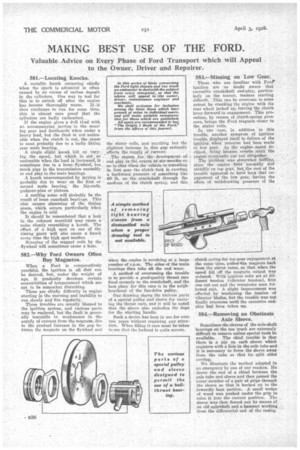MAKING BEST USE OF THE FORD.
Page 70

If you've noticed an error in this article please click here to report it so we can fix it.
Valuable Advice on Every Phase of Ford Transport which will Appeal to the Owner, Driver and Repairer.
581.—Locating Knocks.
A metallic knock occurring chiefly when the spark is advanced is often caused by an excess of carbon deposit in the cylinders. One way to test for this is to switch off after the engine
has become thoroughly warm. If .it then continues to run for some time, this is almost sure proof that the cylinders are badly carbonised.,
If the engine gives a dell thud with an accompanying jarring in the steering gear and footboards when under a heavy load, but the thud is not noticeable when the clutch is out, the cause is most probably clue to a badly fitting rear main bearing.
A single slight knoek felt op varying the speed, but -which is not ; §t1 noticeable when the load is increased, iS sometimes duo to a loose ftywheeL, too much play in the transmission assembly or end play in the main bearings.
A knack unaccompanied by jarring is probably due to wear on the first or second main bearing, the big-ends, gudgeon-pins or pistons.
A rattling noise will probably be the result of loose camshaft bearings. This also causes slamming of the timing gears, which occurs particularly When the engine is cold.
It should be remembered that a leak in the exhaust manifold may cause a noise cIbeely resembling a knock. The effect of a high spot on one of the timing gears will also cause a knock every time the high spot meshes.
Screping of the magnet coils by the flywheel will sometime si Crillfie a limn.
582.—Why Ford Owners Often Buy Magnetos.
When a Ford is comparatively youthful, the ignition is all that can he desired, brit, under• the weight of age, it'gradually develops certain eccentricities of temperament which are apt to be somewhat disturbing.
These are chiefly difficulty in engine starting in the morning and inability to run slowly and -tire regularly.
These troubles are usually blamed to the ignition system, and various parts may be replaced, but the fault is generally traceable to weaknesses in the stlInny of current from the magneta, due to the gradual increase in the gap between the magnets on the flywheel and
the stator coils, and anything but the slightest increase in this gapseriously affects the Supply of current: The tenSeia fort , thedevelopment, of -end play in the course of air months -or .an-is that whew the vehicle is travelling in first gear the clutch fork is exerting a backward pressure of something like 60lb. on the crankshaft through the medium of the clutch sprine, and this when the engine IS reeelving at. a large. number of r.p.m. The sides of the main bearings then take all the end wear.
A method of overcoming the trouble is toprovide a gnod-quality thrust race fixed securely to the crankshaft, and the best place for thie race is in the neighbourhood of the fan-drive pulley.
Our drawing shwa the various parts of a special pulley and sleeve for carrying the thrust race, and it will be noted that the sleeve also embodies the doge for the starting handle.
Such a device has been in use for over two years without requiring any attention. When filling it care must be taken to see that the locknut is quite secure.
583.—Missing on Low Gear.
Those who are familiar with Fore ignition are no doubt aware that excessive crankshaft end-play, particularly on the tanner, renders starting difficult. This can be overcome to some extent by cranking the engine with the rear wheel jacked up, leaving the clutch lever forward in engagement. This procedure, by reason of clutch-spring pressure, brings the Ford magnets closer to the stator coils.
In one case, in. addition to this trouble, another symptom of ignition trouble displayed itself in. failure of the ignition when recourse had been made to low gear. .9.e the enginespeed. declined, firing , became :erratic ;until the engitie eventually cut out altogether.
The problem was stemewhat baffling. since the engine fired normally and steadify•on tap gear, hutethe root of the trouble appeared to have been that engagenient of the low gear, having the effect of withdrawing pressure of the clutch spring for top-gear engagement at the Male time. pulledethe magnets back from the stator cores, so that when the speed fell off the magneto output was reduced. With 'ignition coils set at different tension (vibrator tension), first one cut out and the remainder soon followed suit. A slight improvement was effected by weakening the tension of vibrator blades, but the trouble was not filially overcome until the excessive endplay had been taken up.
584.-7-Removing an Obstinate Axle Sleeve.
Sometimes the sleeves of the axle-shaft bearings on the ton truck are extremely difficult to remove unless special tools be available. The chief trouble is that there is a pip on each sleeve which registers with a hole in the axle tube and it is necessary to force the sleeve away from the tube so that its split sides overlap.
We illustrate the method adopted in an emergency by one of our readers. Ile drove the end of a chisel between the axle tube and sleeve and then passed the inner member-of a pair of grips through the sleeve so that it hooked on to the inwardly bent portion. A small wedge of wood was pushed under the grip to raise it into the correct position. The sleeve was then forced out by means of an old axle-shaft and a hammer working from the differential end of the casing.




















































































































